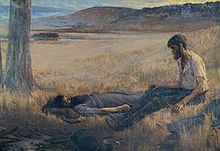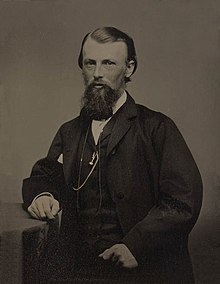Burke and Wills expedition
The expedition established a depot camp at Cooper Creek, and Burke, Wills and two other men pushed on to the north coast (although dense swampland stopped them from reaching the northern coastline).The return journey was plagued by delays and monsoon rains, and when Burke's party reached the depot at Cooper Creek, they found it had been abandoned just hours earlier.The influx of educated gold seekers from England, Ireland and Germany led to rapid growth of schools, churches, learned societies, libraries and art galleries.The instructions were signed by the Honorary Secretary Dr John Macadam and in part advised: "The object of the Committee in directing you to Coopers Creek is that you should explore the country intervening between it and Ludwig Leichhardt's track south of the Gulf of Carpentaria avoiding as far as practicable Sturt's route on the west and Gregory's down the Victoria on the east….. should you determine the impracticability of this route you are desired to turn westward into the country recently discovered by Stuart and connect his furthest point north with Gregory's furthest southern exploration in 1856.....Burke was concerned Stuart might beat him to the north coast and he soon grew impatient with the expedition's slow progress, often averaging only 2 mi (3.2 km) an hour.Burke therefore split the group, taking fifteen horses, sixteen camels and the seven fittest men; Wills, Brahe, Patton, McDonough, King, Gray and Dost Mahomet.Wright was appointed third-in-command and travel was relatively easy because recent rain made water abundant, and the unusually mild weather temperatures exceeded 90 °F (32 °C) only twice.At Torowotto, Wright, Barkinji and the other Aboriginal guide were sent back to Menindee to bring up the remainder of the men and supplies, while Burke's party continued on to Cooper Creek.[22] Guided by another two Aboriginal men, Burke's party soon reached Lake Altiboulka (Altoka) and then travelled through the Caryapundy floodplains to the Bulloo River, which was also known as Wright's Creek.Knowing that the sea must be close, but with the ground being boggy, Burke and Wills decided to leave the camels behind with King and Gray at Camp 119 and set off through the swamps to the coast.The party had actually waited for eighteen weeks and was running low on supplies and starting to feel the effects of scurvy; they had come to believe that Burke would never return from the Gulf.Wright's group had only departed Menindee at the end of January 1861 and made very slow progress due to hot weather and a lack of water availability.[22] Burke, Wills and King arrived at Camp 65 in the evening of Sunday, 21 April 1861, finding the Cooper Creek depot deserted after Brahe's group had left earlier that day.Wills and King wanted to follow their outward track back to Menindee, but Burke overruled them and decided to attempt to reach the furthest outpost of pastoral settlement in South Australia, a cattle station near Mount Hopeless.After leaving the "Dig Tree", Burke's party rarely travelled more than 5 mi (8.0 km) a day, mostly following paths used by the local Aboriginal residents.The region was well populated with Yandruwandha people and they were very courteous to the three explorers, giving them fish, beans called padlu and a type of damper made from the ground sporocarps of the ngardu (nardoo) plant (Marsilea drummondii) in exchange for sugar.Over the next few days, the party encountered several Yandruwandha communities who gave them a variety of cooked foods, including fish, nardoo, native rats and padlu.He became more closely united with this clan after he attempted to heal a skin sore on a woman named Carrawaw, and lived with them for around a month until he was found on 15 September by the rescue expedition led by Alfred Howitt.Howitt gave tomahawks, knives, mirrors, beads, sugar, flour, ribbons and Union Jack handkerchiefs to the Yandruwandha for their kind treatment toward Burke, Wills and King.The party, consisting of twelve mounted men, seven of them ex-troopers from the Native Police Corps, started from Rockhampton on 7 September 1861 with the goal of reaching the Gulf of Carpentaria.[46] McKinlay then decided to make exploration the focus of his expedition and headed in the direction of Central Mount Stuart, but was driven back by heavy rains and floods.By 20 May 1862, McKinlay was around five miles (8 km) from the shore of the gulf, but the intervening country was found to be impassable and he decided to turn east and make for Port Denison on the north coast.[53] Bergin, who recreated the original journey from Cooper Creek to the Gulf of Carpentaria with camels in 1978, showed that a lack of money and too few pack animals to carry supplies meant Wright was placed in an unenviable position.His requests to the Exploration Committee were not acted on until early January, by which time the hot weather and lack of water meant that the party moved extremely slowly.Burke's abrasive personality, poor decision making and hostile behaviour to some of his fellow expeditioners and to local Aborigines has also been pointed out as contributing factors to the disaster."[58] Subsequent historians have posited that the commissioners were compromised by their close relationships with members of the RSV and failed to question them with the same zeal that was applied to men like Brahe.[59] Howitt sailed from Adelaide to Melbourne on the SS Havilah with the remains of Burke and Wills in a small wooden box, arriving at Hobson's Bay on 28 December 1862.[62] It was originally proposed that the funeral should take place at St James Cathedral, but it was decided this would be impractical because of the expected crowds and the difficulty of moving the coffins into the church from the grand mourning vehicle.This small example of ecumenism is interesting given the general enmity and divisive sectarianism between Irish Catholics and English Protestants that blighted Victoria's history over the previous century.At 8pm that evening there was a public meeting at St George's Hall, where Macadam addressed the crowd, and acknowledged the contributions of Ambrose Kyte, Howitt and Commander Norman.



















Burke & WillsRoyal Society of VictoriaRobert O'Hara BurkeWilliam John WillsMelbourneGulf of CarpentariaIndigenousMenindeeDarling RiverCooper CreekmonsoonJohn KingColony of Victoriagold rushSydneyBritish Empiremarvellous MelbourneUniversity of MelbourneState Library of VictoriaRoyal CharterAustralian Overland Telegraph LinetelegraphDutch East IndiesCeylonAlbanyWestern AustraliaAdelaideGovernment of VictoriaGovernment of South AustraliaSouth AustraliaWilliam StruttNew South WalesAmbrose KyteFerdinand von MuellerWilhelm Blandowskifactionalismcolonial forcesbushcraftLudwig LeichhardtSturt'sStuartGregory'sSir William Foster StawellChief Justice of VictoriaDr John MacadamProfessor Georg NeumayerFrederick McCoyAndrew ClarkeMayor of MelbourneFrancis CadellAlfred Selwyn Esq.Reverend Father Dr John Ignatius BleasdaleClement HodgkinsonEdward WilsonThe ArgusAustralian feral camelCamelsdesertAustraliaGeorge Coppin'sCremorne GardensParliament HouseRoyal ParkNicholas ChevalierIndian subcontinentHermann BecklerLudwig BeckerMuslimGhazniKanpurriflesrevolversRoyal Park, MelbourneCaptain Francis CadellMurray RiverEssendonLancefieldMia MiaSwan HillBalranaldammunitionscurvyKinchegasurgeonmail coachSouth Australian governmentlongitudeJohn McDouall StuartPaakantyiDick Barkinjisheep stationAboriginalMutawintijiWannamintaTorowottoCaryapundy floodplainsBulloo RiverCaptain Charles SturtAugustus Charles GregoryreconnaissancestockadeStrzeleckiSturt Stony DesertsState Library of New South WalesCamp CXIXBynoe RiverFlinders RiverKukatjwet seasonmonsoonalDiamantina RiverBirdsvillepack animalsportulacapythonAspidites melanocephalusdysenteryBurke RiverBouliaJohn LongstaffBurke and Wills Dig TreeEucalyptus coolabahWilliam HodgkinsonGalali peopleMount HopelessGeorge Washington Lambert

